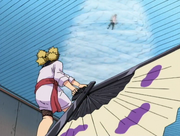No edit summary |
Ravenlot 27 (talk | contribs) m (unnessessary) Tag: sourceedit |
||
| (37 intermediate revisions by 24 users not shown) | |||
| Line 1: | Line 1: | ||
{{Infobox/Jutsu |
{{Infobox/Jutsu |
||
| − | |ref= |
+ | |ref=<ref>First Databook, page 176</ref> |
|image=Kamaitachi.png |
|image=Kamaitachi.png |
||
| − | |kanji=カマイタチ |
+ | |kanji=カマイタチの術 |
|unnamed jutsu=No |
|unnamed jutsu=No |
||
|romaji=Kamaitachi no Jutsu |
|romaji=Kamaitachi no Jutsu |
||
|literal english=Sickle Weasel Technique |
|literal english=Sickle Weasel Technique |
||
| − | |english tv=Wind Scythe Jutsu |
+ | |english tv=Ninja Art: Wind Scythe Jutsu |
|jutsu rank=C |
|jutsu rank=C |
||
|jutsu classification=Ninjutsu |
|jutsu classification=Ninjutsu |
||
| Line 16: | Line 16: | ||
|debut anime=43 |
|debut anime=43 |
||
|debut shippuden=No |
|debut shippuden=No |
||
| + | |novel debut=Shikamaru Hiden: A Cloud Drifting in Silent Darkness |
||
| ⚫ | |||
| + | |game debut=Naruto: Ninja Council |
||
| ⚫ | |||
}} |
}} |
||
| − | This bold move is Temari's |
+ | This bold move is Temari's speciality. By freely manipulating the gale brought forth by her [[Giant Folding Fan]], the many air currents collide and create vacuum pockets. The person enveloped by this gale is assaulted by countless invisible blades, carving up their body. Also, the strong wind power will blow away all incoming projectile weapons and will even make the opponent unable to stay on their feet. |
| − | Temari has also |
+ | Temari has also shown the ability to manipulate the form of the gale, creating a tornado to envelop and lift her opponent, while also cutting them several times. In Part II, she is skilled and accurate enough to cut away the armour of a [[samurai]] without injuring the wearer.<ref>Chapter 464, page 4</ref> |
== Trivia == |
== Trivia == |
||
| − | * A {{translation|[[ |
+ | * A {{translation|[[Wikipedia:Kamaitachi|sickle weasel]]|窮奇; 鎌鼬|kamaitachi}} is a creature from Japanese mythology, said to ride on gusts of wind, cutting people with his sharp, sickle-like claws. Temari's summon, [[Kamatari]], is a sickle weasel. |
| + | * In [[The Power of Darkness…!!|chapter 464]], its name is written as "鎌いたちの術". |
||
| + | |||
| + | == See Also == |
||
| + | * [[Bashōsen: Coil of Wind]] |
||
== References == |
== References == |
||
<references/> |
<references/> |
||
| + | |||
| + | [[es:Jutsu: Hoz Comadreja]] |
||
Revision as of 14:21, 8 January 2016
This bold move is Temari's speciality. By freely manipulating the gale brought forth by her Giant Folding Fan, the many air currents collide and create vacuum pockets. The person enveloped by this gale is assaulted by countless invisible blades, carving up their body. Also, the strong wind power will blow away all incoming projectile weapons and will even make the opponent unable to stay on their feet.
Temari has also shown the ability to manipulate the form of the gale, creating a tornado to envelop and lift her opponent, while also cutting them several times. In Part II, she is skilled and accurate enough to cut away the armour of a samurai without injuring the wearer.[2]
Trivia
- A sickle weasel (窮奇; 鎌鼬, kamaitachi) is a creature from Japanese mythology, said to ride on gusts of wind, cutting people with his sharp, sickle-like claws. Temari's summon, Kamatari, is a sickle weasel.
- In chapter 464, its name is written as "鎌いたちの術".

